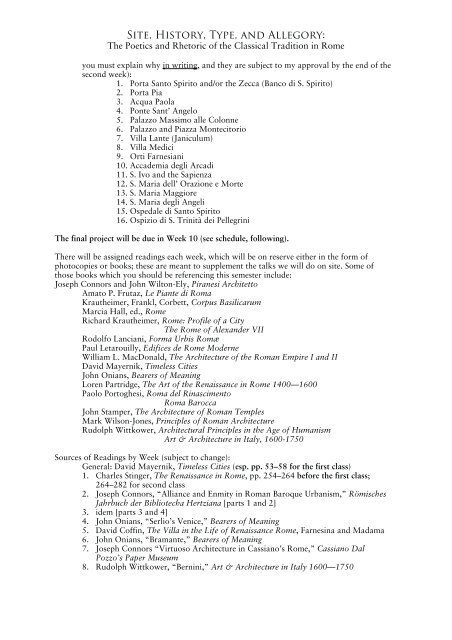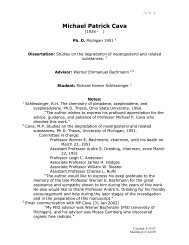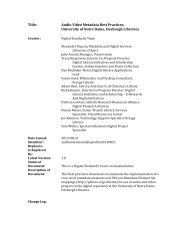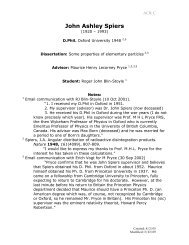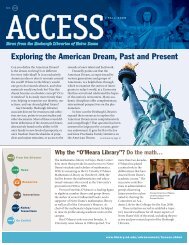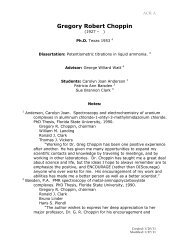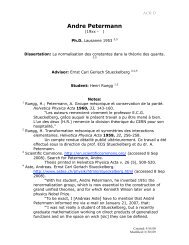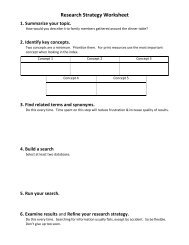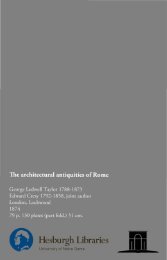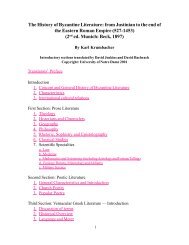ARCH 84312
ARCH 84312
ARCH 84312
You also want an ePaper? Increase the reach of your titles
YUMPU automatically turns print PDFs into web optimized ePapers that Google loves.
Site, History, Type, and Allegory:<br />
The Poetics and Rhetoric of the Classical Tradition in Rome<br />
you must explain why in writing, and they are subject to my approval by the end of the<br />
second week):<br />
1. Porta Santo Spirito and/or the Zecca (Banco di S. Spirito)<br />
2. Porta Pia<br />
3. Acqua Paola<br />
4. Ponte Sant’ Angelo<br />
5. Palazzo Massimo alle Colonne<br />
6. Palazzo and Piazza Montecitorio<br />
7. Villa Lante (Janiculum)<br />
8. Villa Medici<br />
9. Orti Farnesiani<br />
10. Accademia degli Arcadi<br />
11. S. Ivo and the Sapienza<br />
12. S. Maria dell’ Orazione e Morte<br />
13. S. Maria Maggiore<br />
14. S. Maria degli Angeli<br />
15. Ospedale di Santo Spirito<br />
16. Ospizio di S. Trinità dei Pellegrini<br />
The final project will be due in Week 10 (see schedule, following).<br />
There will be assigned readings each week, which will be on reserve either in the form of<br />
photocopies or books; these are meant to supplement the talks we will do on site. Some of<br />
those books which you should be referencing this semester include:<br />
Joseph Connors and John Wilton-Ely, Piranesi Architetto<br />
Amato P. Frutaz, Le Piante di Roma<br />
Krautheimer, Frankl, Corbett, Corpus Basilicarum<br />
Marcia Hall, ed., Rome<br />
Richard Krautheimer, Rome: Profile of a City<br />
The Rome of Alexander VII<br />
Rodolfo Lanciani, Forma Urbis Romæ<br />
Paul Letarouilly, Edifices de Rome Moderne<br />
William L. MacDonald, The Architecture of the Roman Empire I and II<br />
David Mayernik, Timeless Cities<br />
John Onians, Bearers of Meaning<br />
Loren Partridge, The Art of the Renaissance in Rome 1400—1600<br />
Paolo Portoghesi, Roma del Rinascimento<br />
Roma Barocca<br />
John Stamper, The Architecture of Roman Temples<br />
Mark Wilson-Jones, Principles of Roman Architecture<br />
Rudolph Wittkower, Architectural Principles in the Age of Humanism<br />
Art & Architecture in Italy, 1600-1750<br />
Sources of Readings by Week (subject to change):<br />
General: David Mayernik, Timeless Cities (esp. pp. 53–58 for the first class)<br />
1. Charles Stinger, The Renaissance in Rome, pp. 254–264 before the first class;<br />
264–282 for second class<br />
2. Joseph Connors, “Alliance and Enmity in Roman Baroque Urbanism,” Römisches<br />
Jahrbuch der Bibliotecha Hertziana [parts 1 and 2]<br />
3. idem [parts 3 and 4]<br />
4. John Onians, “Serlio’s Venice,” Bearers of Meaning<br />
5. David Coffin, The Villa in the Life of Renaissance Rome, Farnesina and Madama<br />
6. John Onians, “Bramante,” Bearers of Meaning<br />
7. Joseph Connors “Virtuoso Architecture in Cassiano’s Rome,” Cassiano Dal<br />
Pozzo’s Paper Museum<br />
8. Rudolph Wittkower, “Bernini,” Art & Architecture in Italy 1600—1750


